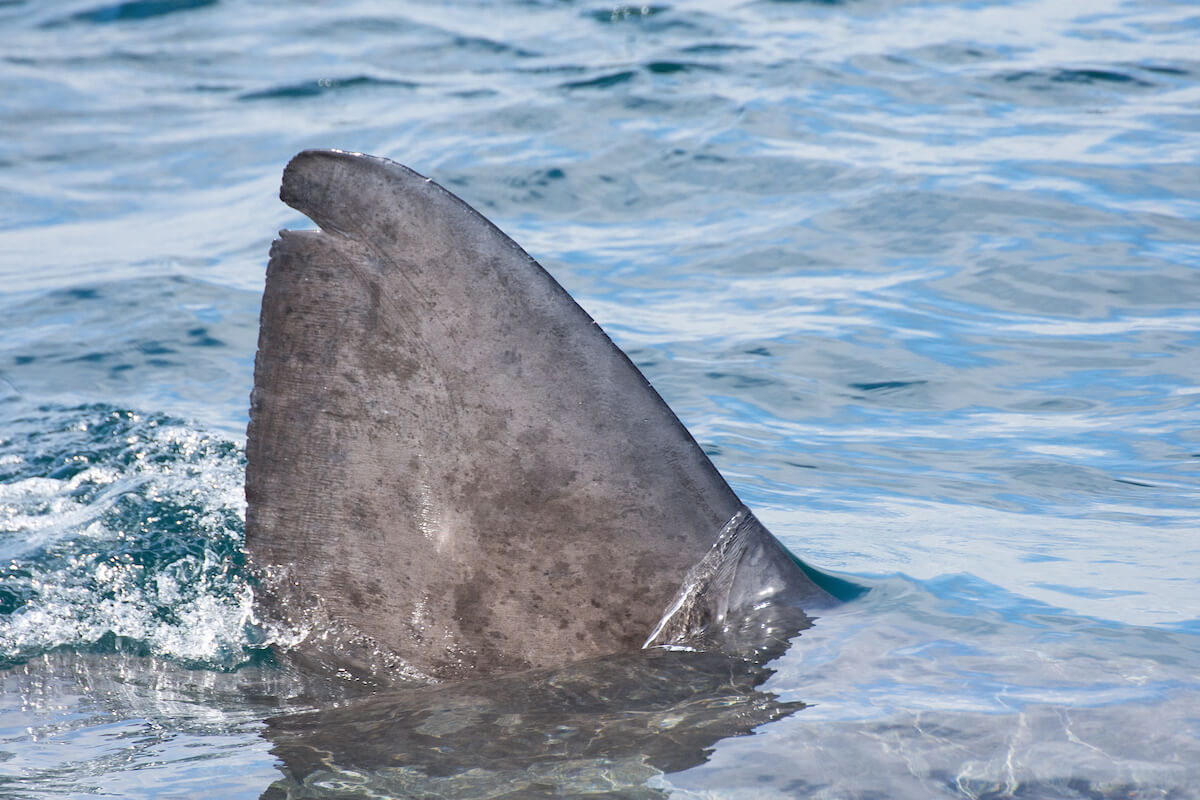
Shark-Cast Episode 6: Basking Sharks – Your Questions Answered
Oct 07 2022

Welcome to episode 6 of shark-cast brought to you by Basking Shark Scotland. This episode Shane and Rachel dived into an introduction to the basking shark – (we are always here for the ocean puns!). There is so much we could talk about for this topic, but we narrowed it down by asking our audience on social media for their questions.
Shark-Cast is the only dedicated podcast all about basking sharks, you can listen monthly wherever you get your podcasts. If you would prefer to read about the ‘Introduction to the basking Shark’ you can see the highlights from the podcast below!
The Basking Shark – Your Questions Answered!
After 10 years of basking shark tours we certainly have become acquainted with this fish, but the basking shark is still relatively unknown to the public, so let’s get to know the basking shark!
Rachel – So, basking shark Scotland has been going for 10 years now, so it’s fair to say you’ve probably seen your fair share of sharks?
Shane – As one person once said ‘once you’ve seen one you’ve seen them all!’
Rachel – Who said that?!
Shane – It’s on trip advisor, look back to 2013, it was great for the tours because they said something like we saw 25 sharks, but really it was boring because once you’ve seen one you’ve seen them all.
Rachel – Haha brilliant! Tick that one off the list! Well, as we are based here in there Hebrides, this is a good question to start with…
How many basking sharks are in the UK?
Shane – Interesting one, The answer to this is not currently known. The closest we have come to answering that is from a study done by Mauvis Gore and Rupert Ormond, two scientists connected with Herriott-Watt who run a project called ‘Project Basking Shark’. They have been doing lots of studies here on the sharks, and released a paper a few years ago based on their photo ID work. Basically, they went out each summer photographing basking shark fins on each side, collected lots of photos of individuals, looking to do a method called ‘mark-recapture’. They would then continue to take pictures of the fins to get a match, they spent lots of time going through the photos of fins, it’s hard work as there are not too much noticeable differences in them, unless there is a big notch or damage. There are lots of subtleties with the shape of the fin, small scratches, how rounded the tip is and small marks. But they had a successful study and collected lots of samples. They found through the number of mark-recapture and number of new sharks sighted that they could make an estimate for the population, the estimate was 20,000 sharks in the North East Atlantic.
Generally the sharks migrate to and from the Hebrides, via the west side of the UK and Ireland, and it’s likely that a lot of those sharks sighted are the same we see here in Scotland. Another interesting thing to note is that we estimate 100,000 were removed from the population by fishing practices.
Rachel – Its crazy to think how many there would have been years ago, on a good day on Coll when there are sharks everywhere that’s just a fraction of what it would have been formerly. The accounts I always remember reading is where ‘basking sharks are described as stepping stones on the sea’.
Are they here all year round, or do they migrate?
Shane – Lawson Wood, a Scottish underwater photographer, who is well known for his diving guides and articles, actually saw one in Fort William in a Sea Loch in winter. A fairly tea-coloured dark water, lots of objects were sunk there to make a dive attraction close to the pier. He was swimming around there in the winter, where it was pretty cold and dark, and a basking shark appeared out of the 3 metre gloomy water! As you can image, it was quite the shock!
Some do over-winter here in Scotland, and through tagging projects we do know that some sharks also migrate during the winter. Some head towards the sub-tropics, and others across the Atlantic. The ones tagged here in the Hebrides, have mostly headed down towards the Bay of Biscay, the Azores and the Canaries. Previous tagging papers have found interesting behaviours in their depths at certain times of year, of course at this time of year we can’t see them – so we just have a small snapshot of what they are doing at this time! Usually they head off in the Autumn and arrive back in the Spring, April is the earliest we have seen basking sharks in Scotland!
Rachel – We’ve just had our first sighting of the year here in the Hebrides last week! So that’s always good news to see the big fish popping back up!
What is the best time of year to see basking sharks?
So to answer this we need to understand a bit more about ocean conditions, basking shark sightings are hard to predict.
Shane – Shark sightings begin in the spring and culminates in the summer, which could be potentially due to two things. We see behaviours which indicate mating, and they are also taking advantage of the huge food source here during the summer. We see two plankton blooms, one in the spring – with all the warmth and nutrients becoming available. Another in the summer July and August, this is usually the time we see the most sharks. Southerly locations start to see them around the spring plankton bloom. But it doesn’t always follow this pattern, we have seen lots of sharks in October in the past too. Plankton depends on so many factors, heat, water, light, nutrients. The best time to see the sharks is when the plankton soup is in its optimal conditions, this can affected by huge oceanographic factors from the winter, and offshore weather systems.
We spend lots of time searching for sharks at the peak time, July – September, this is also the time we have seen these mating behaviours. The other difficulty is being fish, basking sharks don’t actually have to come to the surface. We only see them when their dorsal fin breaks the water, so they could be here, in deeper water and we wouldn’t know.
How long do basking sharks live?
Shane – Another hard one! There is no information to answer this, we think they live for a long time with a rough estimate being over 50 years old. But many academics think that they would live longer than this due to their late maturity.
Rachel – Basking sharks are often described as having a long life history, in terms of sexual maturity, which is a problem conservation-wise, as they have a low reproductive rate too. It’s a hard one to quantify, finding the age and weight of a basking shark, with their size they aren’t an easy sample to handle!
When it comes to questions about basking sharks we find a lot of the answers are ‘science still doesn’t know!’. We do hope as we continue to contribute sightings data we will discover more about this species.
When do basking sharks give birth and where?
You guessed it – we don’t know!
The problem with studying basking sharks is they do these huge migrations where they disappear into thousands of meters of water for long periods, and we simply don’t have the technology available to follow them.
What we do know is, we don’t see many small ones here, we have only seen maybe 2-3 very small juveniles. They are very distinct as they have funny turned-up noses. Likely, they are not pupping in this area as we are not seeing many young ones, they could be doing this at depth, but when we have seen juveniles we have seen them feeding. So if there were more young sharks in the area you would expect to come across more at the surface.
In the Mediterranean, they do see a lot of smaller basking sharks, in the late winter, and early spring tagging data shows many basking sharks spend this time at a depth around the Bay of Biscay, so this could be an important location. Finding out where the sharks are pupping would be really important to help protect this species!
Rachel – It’s interesting the amount of time people spend by the coast and in the water, nobody has yet seen that. Even ourselves, spending ten years on the water looking at basking sharks haven’t seen any signs of this.
Shane – There’s not even much information from fishing data, except the one account of the Norwegian fishing vessel that caught one and it spontaneously gave birth.
Rachel – Yes, that shark had 6 pups, which again is the only data we have to go off for their number of young. That goes back to us just having snippets of information, and small sample sizes when it comes to basking sharks. Though we did find some new science here recently in the Sea of the Hebrides. Deployed camera tags caught sight of some unusual behaviour on the bottom of the seabed.
Why do so many basking sharks have white snouts?
When we look at basking sharks during our sightings we take note of any unusual scarring and markings. We had a couple of questions about different scarring, on both the nose and the underside of the shark creating noticeable white sharks.
Shane – Sharks’ skin is tough, but also abrasive. When they are mating they latch on to each other with their teeth which cause scarring on their fins. They also interact with each other and swim into things such as ropes and rocks. They are also associated with lots of parasites, compared to other sharks like great whites, basking sharks look a bit grubbier! This could be their slow cruising speed.
Rachel – Sharks have this amazing capability to heal, they have white marks from lamprey attachment which show where they have become removed.
When did the first basking sharks evolve?
Rachel – basking sharks first appeared on the fossil record 30 million years ago – we know that sharks are way older than that. Their last branching common ancestor with the lamniformes first appeared on the fossil record 80 million years ago. Sharks are hard to study being cartilaginous, with this not preserving as easily as bones.
Why do basking sharks breach?
Basking sharks are the largest shark to breach clean out of the water, and we have noticed it happening more at certain times of year when we also see other presumed mating behaviour.
We see it more often when there seem to be more sharks in the area, recent papers with accelerometers found the velocity they would breach and the frequency and times. We found that they were doing this during the night! We don’t know for sure as there are theories about parasites, reproduction, and communication.
Read more about why basking sharks breach here.
Do basking sharks smile?
Funny, some photos do look like basking sharks are smiling! When they have a full tummy of plankton we think they are smiling! What do you think?
Who would win in a fight, a basking shark or a whale shark?!
This question is from our guide Jack (of course!), whilst whale sharks are bigger, basking sharks can breach out of the water, you’ll have to listen to the podcast to hear our final verdict!






